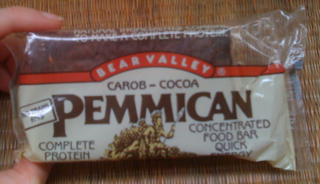Thompson 1810 at Cumberland House, Saskatchewan: On the west side of these alluvials is Cumberland Lake, on the east bank of which is situated Cumberland House in Latitude 53° . 56' . 45" N Longitude 102 . 13 West. This House was the first inland trading post the Hudson's Bay Company made, remarkably well situated for the trade of fine Furrs: it serves as the general Depot for all the dried Provisions made of the meat and fat of the Bison under the name of Pemican, a wholesome, well tasted nutritious food, upon which all persons engaged in the Furr Trade mostly depend for their subsistence during the open season; it is made of the lean and fleshy parts of the Bison dried, smoked, and pounded fine; in this state it is called Beat Meat: the fat of the Bison is of two qualities, called hard and soft; the former is from the inside of the animal, which when melted is called hard fat (properly grease) the latter is made from the large flakes of fat that lie on each side the back bone, covering the ribs, and which is readily separated, and when carefully melted resembles Butter in softness and sweetness. Pimmecan is made up in bags of ninety pounds weight, made of the parchment hide of the Bison with the hair on; the proportion of the Pemmecan when best made for keeping is twenty pounds of soft and the same of hard fat, slowly melted together, and at a low warmth poured on fifty pounds of Beat Meat, well mixed together, and closely packed in a bag of about thirty inches in length, by near twenty inches in breadth, and about four in thickness which makes them flat, the best shape for stowage and carriage. On the great Plains there is a shrub bearing a very sweet berry of a dark blue color, much sought after, great quantities are dried by the Natives; in this state, these berries are as sweet as the best currants, and as much as possible mixed to make Pemmecan; [Service berry, June berry, Amelanchier alnifolia Nutt.] the wood of this shrub, or willow is hard, weighty and flexible, but not elastic, and wherever it can be procured always forms the Arrow of the Indian, the native name is Mis-sars-cut; to which mee-nar is added for the berry; we call it by the native name, but the french who murder every foreign word call the Berry, Poires, and Pim-me-carn; Peemittegar. I have dwelt on the above, as it [is] the staple food of all persons, and affords the most nourishment in the least space and weight, even the gluttonous french Canadian that devours eight pounds of fresh meat every day is contented with one and a half pound per day: it would be admirable provision for the Army and Navy. It is at Cumberland House all the Pimmecan, and dried provisions of all kinds procured from the great Plains are brought down the Saskatchewan and deposited here, and which forms the supply for the furr Traders going to, and coming from, all the trading Posts;





